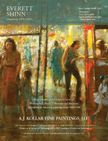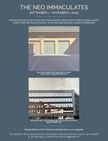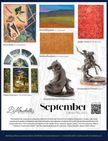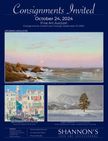The American Renaissance, also known as the Golden Age, was an era when art for the public came to prominence in American life. The movement, which swelled between the country’s centennial celebration and the onset of World War I, was largely an architectural one—most of the grand civic spaces in the nation were designed and built during this period—but it depended heavily on a collaboration with the American artists of the day to realize a collective vision.
 Edwin Austin Abbey (1852-1911), Study for The Castle of the Maidens in The Quest of the Holy Grail Cycle at the Boston Public Library, ca. 1895-1900. Pastel on gray paper. Yale University Art Gallery, Edwin Austin Abbey Memorial Collection.
Edwin Austin Abbey (1852-1911), Study for The Castle of the Maidens in The Quest of the Holy Grail Cycle at the Boston Public Library, ca. 1895-1900. Pastel on gray paper. Yale University Art Gallery, Edwin Austin Abbey Memorial Collection.
With The Dance of Life: Figure and Imagination in American Art, 1876-1917, on view September 6, 2024, through January 5, 2025, Yale University Art Gallery examines the vitality and expressivity of the human figure in working studies for large commissions at civic institutions nationwide during a pivotal moment in American history.
“Historically, the most prominent event in peoples’ lives in this generation was the Civil War,” says Mark D. Mitchell, the gallery’s Holcombe T. Green Curator of American Paintings and Sculpture, and curator of The Dance of Life. “A whole generation of Americans had died in just a few years. There is a sense of incredible grief over the consequences of the Civil War and it takes more than a decade for American artists to find a way to respond to that watershed in American history, which was called the second American Revolution.
 Edwin Austin Abbey (1852-1911), Study for The Castle of the Maidens in The Quest of the Holy Grail Cycle at the Boston Public Library, ca. 1895-1900. Pastel on gray paper. Yale University Art Gallery, Edwin Austin Abbey Memorial Collection.
Edwin Austin Abbey (1852-1911), Study for The Castle of the Maidens in The Quest of the Holy Grail Cycle at the Boston Public Library, ca. 1895-1900. Pastel on gray paper. Yale University Art Gallery, Edwin Austin Abbey Memorial Collection.
“They turned to life rather than death,” continues Mitchell. “They turned to the body and figure as a symbol of rebirth and hope…The aspiration in these artists was to create something new. That represented a dramatic change in the aspirations of American artists not just to be a reflection of the character and history of the nation, but to try to communicate its ideals through the human figure in monumental form.”

From pencil drawings and pastels, to dynamic bronzes and oil paintings, the exhibition features more than 100 studies that provide unparalleled insight into the creative process and the, at times obsessive efforts that went into transforming an artist’s vision into reality. These studies were often exhibited as works of art in their own right, and many regard them as more compelling than the completed commission.
Among the leading artists showcased in the exhibition are Edwin Austin Abbey, Edwin Blashfield, Daniel Chester French, Violet Oakley, Augustus Saint-Gaudens and John Singer Sargent, as well as lesser known talents such as Meta Warrick Fuller, Evelyn Longman and Gari Melchers.
In preparatory studies for commissions destined to fill a wave of new public spaces—libraries, universities, courthouses, museums, state capitols, train stations and parks—the artists used the human figure to communicate with their audiences about community, memory and identity.
 John La Farge (1835-1910), Study for Isaiah at Trinity Church, Boston, 1876. Watercolor on paper. Trinity Church, Boston. Photo © 2024 Museum of Fine Arts, Boston.
John La Farge (1835-1910), Study for Isaiah at Trinity Church, Boston, 1876. Watercolor on paper. Trinity Church, Boston. Photo © 2024 Museum of Fine Arts, Boston.
“The figure is the most resonant historical form and the period to which these artists looked was the Italian Renaissance,” says Mitchell. “In that they found an appeal to the universal, to the ability of art to speak to anyone and to communicate a story and idea without text or any kind of preparation on the part of the viewer. And to offer a sense of a universal human experience that could be shared very widely to affect a broad community of people. That reflected a very democratic ambition on the part of American artists to share art widely and to make it part of American life. These artists looked at public or civic art as the highest calling for artists to join a very august history of art making for the first time.”
The exhibition is focused on artists’ contributions to two civic landmarks: the Boston Public Library and the Pennsylvania State Capitol in Harrisburg. It is built upon the gallery’s collection of 3,000 works by Edwin Austin Abbey (1852-1911), and complemented with loans of rarely seen artworks from the collections of the Art Institute of Chicago, Harvard University Art Museums, the Metropolitan Museum of Art, Museum of Fine Arts Boston and National Gallery of Art.
 Edwin Austin Abbey (1852-1911), Study for The Hours in the Pennsylvania State Capitol, ca. 1909-11. Oil on canvas. Yale University Art Gallery, Edwin Austin Abbey Memorial Collection.
Edwin Austin Abbey (1852-1911), Study for The Hours in the Pennsylvania State Capitol, ca. 1909-11. Oil on canvas. Yale University Art Gallery, Edwin Austin Abbey Memorial Collection.
Abbey, who flourished in the early years of the American Renaissance, conceived of murals for both buildings, his most famous set of which, The Quest and Achievement of the Holy Grail, were installed in the Boston Public Library in 1895-1902.
According to the Boston Public Library, “When architect Charles Follen McKim and sculptor Augustus Saint-Gaudens approached Abbey for the commission, the young artist had already established himself as an illustrator for the popular Harper’s Weekly magazine, but he had comparatively little experience working in oil paint. With some coaxing, Abbey agreed to take on the ambitious project, ultimately deciding to depict Sir Galahad’s quest for the Holy Grail.”
 John Singer Sargent (1856-1925), Pietro Corsi, ca. 1891-95. Oil on canvas. Yale University Art Gallery, Edwin Austin Abbey Memorial Collection.
John Singer Sargent (1856-1925), Pietro Corsi, ca. 1891-95. Oil on canvas. Yale University Art Gallery, Edwin Austin Abbey Memorial Collection.
Abbey’s study for The Castle of the Maidens, one of 15 scenes in the frieze The Quest of the Holy Grail, was executed in pastel on gray paper; while another is a radiant watercolor featuring two iterations of the same composition on one piece of paper.
Perhaps one of Abbey’s most impressive works in the exhibition is Study for The Hours, ca. 1909-11, a circular celestial design for the ceiling of the House of Representatives in the Pennsylvania State Capitol.
“The Hours becomes the most freely creative and non-programmed of Abbey’s work,” says Mitchell. “It’s just this richly, vividly colored, series of figures, moving around the ceiling of the chamber. He did hundreds of studies—it became an obsession for him. Through them you get a sense for the rigorous process of study it required to create this single procession of figures. It becomes a kind of individual expression of movement and energy itself.”
 Violet Oakley (1874-1961), Study for Lincoln at Gettysburg—The Preservation of the Union in the Senate Chamber, Pennsylvania State Capitol, ca. 1911. Oil on canvas. Pennsylvania Capitol Preservation Committee. Photo: Courtesy the State Museum of Pennsylvania, Pennsylvania Historical and Museum Commission.
Violet Oakley (1874-1961), Study for Lincoln at Gettysburg—The Preservation of the Union in the Senate Chamber, Pennsylvania State Capitol, ca. 1911. Oil on canvas. Pennsylvania Capitol Preservation Committee. Photo: Courtesy the State Museum of Pennsylvania, Pennsylvania Historical and Museum Commission.
When Abbey died suddenly in 1911, the artist had completed three monumental works for the House: The Apotheosis of Pennsylvania, Penn’s Treaty, and The Hours.
The Dance of Life progresses chronologically, illustrating the shift in figurative civic art from a heavy emphasis on narrative to more a symbolic, movement-based form of expression, where the body was seen as a vehicle for ideas rather than solely as a means of telling a story.
 John Singer Sargent (1856-1925), Study of Clasped Hands for Heaven in The Triumph of Religion Cycle at the Boston Public Library, ca. 1895-1916. Charcoal on off-white laid paper. Harvard Art Museums/ Fogg Museum, Gift of Miss Emily Sargent and Mrs. Francis Ormond in memory of their brother, John Singer Sargent. Photo: President and Fellows of Harvard College.
John Singer Sargent (1856-1925), Study of Clasped Hands for Heaven in The Triumph of Religion Cycle at the Boston Public Library, ca. 1895-1916. Charcoal on off-white laid paper. Harvard Art Museums/ Fogg Museum, Gift of Miss Emily Sargent and Mrs. Francis Ormond in memory of their brother, John Singer Sargent. Photo: President and Fellows of Harvard College.
The exhibition opens with a reduction of Saint-Gauden’s monumental Victory sculpture in New York City’s Grand Army Plaza, which demonstrates how artists often continued to create iterations of works even after the commission was completed. It was also quite groundbreaking that Saint-Gaudens fashioned the piece based on an African American woman, which leads into a section of the exhibition that focuses on artists’ deep engagement with their models at the time.
Also in this section of the exhibition is John La Farge’s 1876 watercolor Study for Isaiah at Trinity Church, Boston, a landmark that marked a turning point in the architectural design and the interior decoration of American churches.
Sargent’s oil Pietro Corsi, ca. 1891-95, depicts an olive-skinned southern Italian man whose arm musculature is prominently defined; and his charcoal Study of Clasped Hands for Heaven in The Triumph of Religion Cycle at the Boston Public Library, illustrates the importance of staying true to the specific human form before them.
Another example is Violet Oakley’s Study for Lincoln at Gettysburg—The Preservation of the Union in the Senate Chamber, Pennsylvania State Capitol, ca. 1911. The oil painting captures the unmistakable stooped silhouette of the former president, which embodied the burdensome weight of the Civil War.
 Edwin Austin Abbey (1852-1911), Figure Study for The Spirit of Vulcan in the Genius of the Workers in Iron and Steel Cycle in the Pennsylvania State Capitol, ca. 1902–8. Oil on canvas. Yale University Art Gallery, Edwin Austin Abbey Memorial Collection.
Edwin Austin Abbey (1852-1911), Figure Study for The Spirit of Vulcan in the Genius of the Workers in Iron and Steel Cycle in the Pennsylvania State Capitol, ca. 1902–8. Oil on canvas. Yale University Art Gallery, Edwin Austin Abbey Memorial Collection.
“These artists were deeply engaged with actual bodies,” explains Mitchell. “They were really committed to individual bodies, and often hired working class models whose bodies were very much shaped by the work they did time. There is a sense of that richness of observation and real descriptions of individual contemporary sitters rather than some wished for ideal of long ago.”
Other thematic sections include “Reaching Out,” which focuses on the illusionary techniques used to engage the viewer’s senses; and “Vital Energy,” as seen in works like Frederick William MacMonnies dynamic bronze The Horse Tamer, ca. 1894-99; while “Light” and “Expression” consider tools and strategies that artists used to depict the human experience. The influence of modern dance and allegorical representations of modernity are addressed in “Dance” and “Modern.”
 Meta Vaux Warrick Fuller (1877-1968), Danse Macabre, 1914. Painted plaster. Danforth Art Museum at Framingham State University, Gift of the Meta V.W. Fuller Trust.
Meta Vaux Warrick Fuller (1877-1968), Danse Macabre, 1914. Painted plaster. Danforth Art Museum at Framingham State University, Gift of the Meta V.W. Fuller Trust.
“These studies are not just vehicles to get somewhere, they are often an end in themselves,” says Mitchell. “They convey a sense of internal aspiration. They show the mind of the artist creating in progress; they show artists trying to answer questions that start with the word ‘how.’ How do I convey this idea; how do I portray movement? The studies show us the ideas unfolding; they show us the process—and the struggle—of creation.”
September 6, 2024- January 5, 2025
The Dance of Life: Figure and Imagination in American Art, 1876-1917
Yale University Art Gallery
111 Chapel Street
New Haven, CT 06519
t: (203) 432-0600, artgallery.yale.edu
Powered by Froala Editor






















